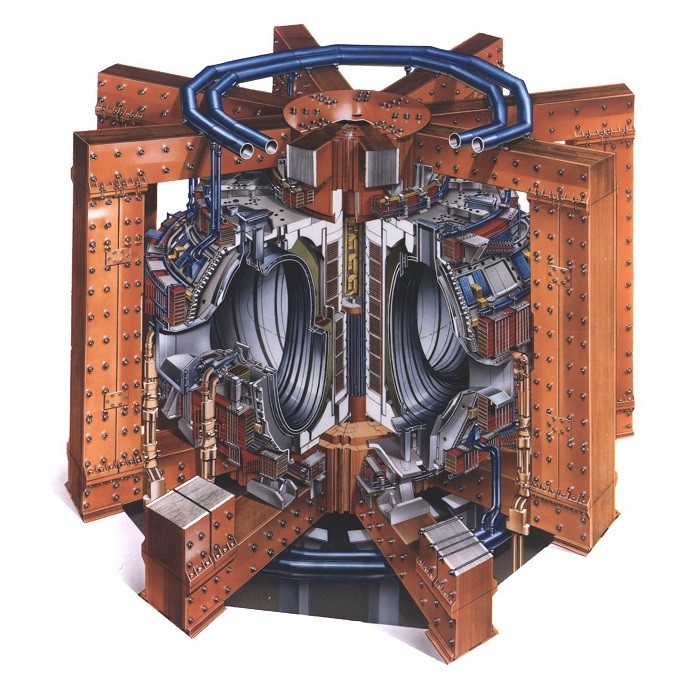
The Joint European Torus (JET) in Oxford managed to achieve a thermonuclear reaction lasting five seconds with a record amount of energy produced. This is an important milestone on the path to fusion energy. More than 300 scientists associated with the EUROfusion consortium, including researchers from the Polish Institute of Plasma Physics and Laser Microfusion in Warsaw (IFPiLM), took part in the experiment, the results of which were presented last week.
In a five-second reaction, one of the largest thermonuclear reactors - Joint European Torus (JET) - produced 69 megajoules of energy from 0.2 mg of fuel. This is a record, say the scientists responsible for the achievement.
JET is a tokamak - a toroidal reactor, in which hot plasma is controlled by strong magnetic fields. In the thermonuclear reaction in the reactor, the nuclei of two hydrogen variants- deuterium and tritium - fuse together, which produces vast amounts of energy.

Many experts believe that in the future, nuclear fusion will be able to meet the growing energy demand of humanity. The main reasons are high energy gain, fuel availability and small amount of radioactive waste.
'We can reliably create fusion plasmas using the same fuel mixture to be used by commercial fusion energy power plants, showcasing the advanced expertise developed over time,’ says Dr. Fernanda Rimini, JET Senior Exploitation Manager.
According to Professor Ambrogio Fasoli, Programme Manager at EUROfusion, which organizes international research on nuclear fusion, the 'successful demonstration of operational scenarios for future fusion machines like ITER and DEMO, validated by the new energy record, instil greater confidence in the development of fusion energy.’
'Beyond setting a new record, we achieved things we’ve never done before and deepened our understanding of fusion physics,’ he adds.
The 300 scientists taking part in the experiment included representatives of the Polish Institute of Plasma Physics and Laser Microfusion in Warsaw (IFPiLM).
'Our determination and international cooperation have produced exceptional results that represent a milestone in fusion energy research. This success not only confirms the ability to control plasma in tokamaks, but also represents a key step towards achieving the goal of commercial-scale energy production using nuclear reaction. There are still many challenges and years of research ahead of us, but I am convinced that our hard work will bring even more innovative solutions that will shape the global energy industry,’ says Dr Agata Chomiczewska from IFPiLM and national coordinator of the JET tokamak research.
Dr. Chomiczewska told PAP that the team's next goal was to obtain higher thermonuclear power for a longer time - just as we would in power plants.
'This requires larger and more advanced devices. One such device will be the ITER tokamak, the next-generation experimental reactor currently under construction in the south of France. In this reactor we should achieve 500 megawatts of thermonuclear power in 300 seconds. ITER is expected to become the world's first device producing 10 times more energy from the fusion of deuterium with tritium than the energy supplied to heat the fuel. The first experiments with deuterium-tritium fuel are planned for the second half of the 2030s. The ultimate goal of the EUROfusion consortium is to create a European demonstration fusion power plant EU-DEMO, which will produce electricity. The launch of this power plant is planned for the second half of the 2050s. It is worth adding that calculation and design work for DEMO is already underway. These projects are such large undertakings that even if everything works perfectly, building the technology itself takes a lot of time, approximately 20 years. Whether the fusion merger ill result in a large share in the energy market, ultimately depends on politics and the public. Our goal is to create the possibility of using fusion,’ says Dr. Chomiczewska.
JET, which has been operating for 40 years, enabled research that was crucial for the next reactor, the more advanced fusion reactor ITER, scheduled to launch this decade.
The next step will be building the DEMO system - the first experimental nuclear fusion power plant.
PAP - Science in Poland, Marek Matacz
mat/ bar/ kap/
tr. RL













